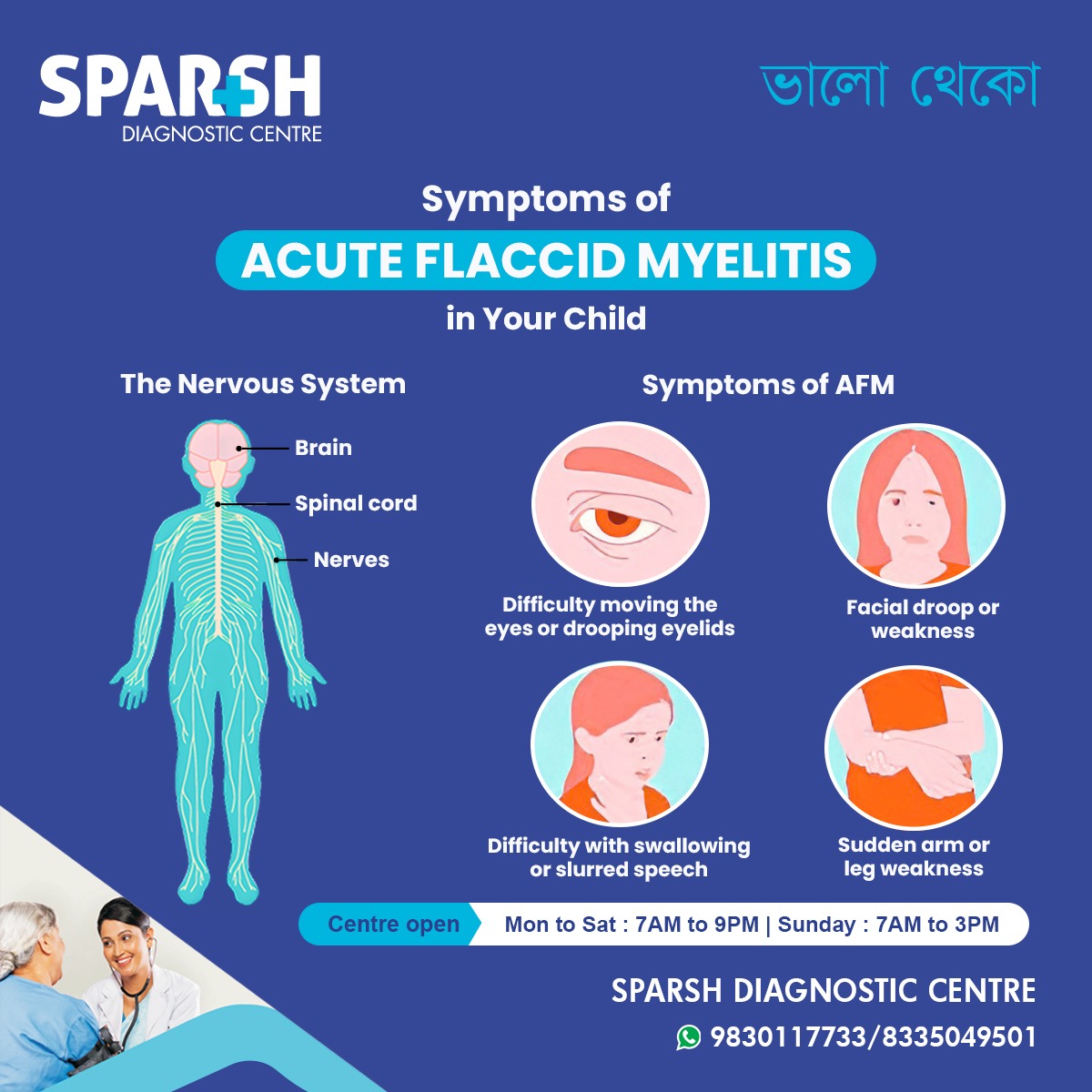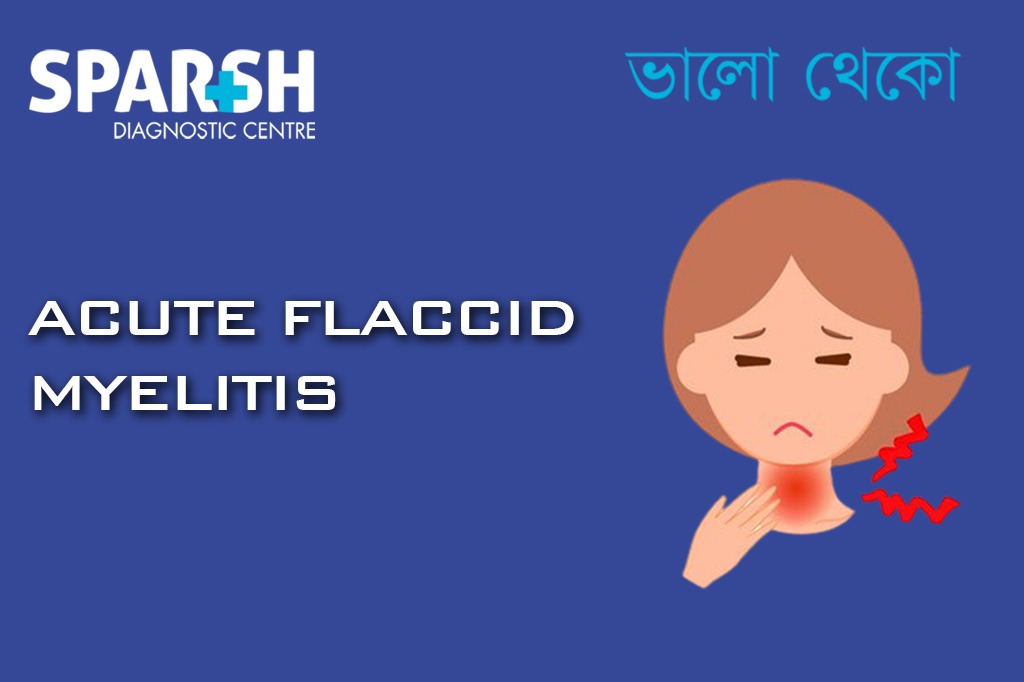Acute Flaccid Myelitis (AFM) is a rare neurological condition that primarily affects children. It leads to sudden muscle weakness and paralysis, often in the arms or legs. AFM targets the spinal cord, particularly the gray matter that controls movement, resulting in weakened reflexes and muscle tone.
Although rare, AFM is a medical emergency that requires immediate diagnosis and supportive care. Understanding its symptoms, causes, and treatment can help parents recognize early warning signs and seek timely medical attention.
What is Acute Flaccid Myelitis (AFM)?
AFM is a polio-like syndrome that causes acute inflammation of the spinal cord. It can result in flaccid paralysis, meaning muscles become weak and limp rather than stiff or spastic.
The term “flaccid” refers to reduced muscle tone, while “myelitis” means inflammation of the spinal cord. AFM can develop suddenly and progress rapidly, sometimes within hours or days.
Who Is Most Affected?
AFM mainly affects children between the ages of 4 and 12, although adults can also develop it in rare cases. The condition is seasonal, with most cases occurring in late summer and early fall. Outbreaks have been reported worldwide, including in the U.S., India, and other regions.
How AFM Affects the Nervous System
AFM damages the spinal cord’s gray matter, which contains nerve cells responsible for sending movement signals to the muscles. This disruption results in sudden weakness or paralysis of limbs and facial muscles.
The Nervous System Components Involved:
Brain: Controls motor functions and reflexes.
Spinal Cord: The main communication highway between the brain and body.
Nerves: Carry signals to muscles for movement.
When inflammation affects these areas, muscle weakness, reflex loss, and paralysis can occur.
Symptoms of Acute Flaccid Myelitis
Early detection is crucial in preventing long-term complications. Symptoms can vary from child to child but often start suddenly.
Common Symptoms Include:
Sudden weakness in the arms or legs – typically on one side of the body.
Facial droop or weakness – making it difficult to smile or close the eyes.
Difficulty moving the eyes or drooping eyelids.
Difficulty with swallowing or slurred speech.
Neck, back, or limb pain before weakness develops.
Loss of reflexes or floppy limbs.
Respiratory weakness in severe cases, which may require ventilator support.
Trouble holding up the head or maintaining posture.

Symptoms Parents Should Watch For
Because AFM progresses rapidly, parents should seek immediate medical help if their child:
Suddenly struggles to move one arm or leg.
Has facial weakness or drooping.
Develops difficulty speaking or swallowing.
Shows any breathing problems or neck stiffness.
Causes of Acute Flaccid Myelitis
The exact cause of AFM isn’t fully understood, but research suggests it is triggered by viral infections that affect the spinal cord.
Commonly Linked Viruses Include:
Enteroviruses, especially Enterovirus D68 (EV-D68).
Coxsackieviruses and Echoviruses.
West Nile Virus and other flaviviruses.
These viruses can cause respiratory illnesses or fever before neurological symptoms appear. In rare cases, AFM may also occur after vaccinations, autoimmune responses, or environmental exposures, though these links are not firmly established.
Risk Factors
Factors that may increase the risk of AFM include:
Age – Most cases occur in children under 12 years.
Seasonal exposure – Late summer and early autumn months.
Viral outbreaks – Particularly of enteroviruses.
Weakened immune system – Increases susceptibility to viral infections.
How AFM Is Diagnosed
Diagnosing AFM requires a combination of clinical evaluation, imaging studies, and laboratory tests.
1. Neurological Examination
A doctor will assess:
Muscle strength and tone.
Reflexes and coordination.
Cranial nerve function (facial and eye movements).
2. MRI Scan
MRI of the spinal cord and brain helps identify inflammation in the gray matter, which is a hallmark sign of AFM.
3. Lumbar Puncture (Spinal Tap)
A small sample of cerebrospinal fluid (CSF) is taken to look for signs of infection or inflammation.
4. Laboratory Tests
Blood, respiratory secretions, and stool samples may be tested for viruses such as enterovirus D68 or West Nile virus.
5. Electromyography (EMG)
EMG measures muscle and nerve activity to detect nerve damage or dysfunction.
Treatment of Acute Flaccid Myelitis
There is currently no specific cure for AFM. Treatment focuses on symptom management, physical rehabilitation, and supportive care.
1. Supportive Care
Hospitalization for close monitoring.
Ventilator support if breathing muscles are affected.
Pain management for associated nerve pain.
2. Physical and Occupational Therapy
Rehabilitation is crucial for improving muscle strength and mobility. It may include:
Physical therapy for limb movement.
Occupational therapy for daily activities.
Speech therapy for swallowing or speaking issues.
3. Medications
Corticosteroids may be used to reduce spinal inflammation.
Intravenous immunoglobulin (IVIG) and plasma exchange therapy have been used in some cases to modulate immune response.
Antiviral medications are sometimes tried, although their effectiveness is uncertain.
4. Long-Term Care
Some children recover fully, while others may have persistent weakness or paralysis. Long-term rehabilitation and assistive devices like braces or wheelchairs may be necessary.
Prognosis
The recovery process varies. Some children regain most muscle function within months, while others experience permanent weakness. Early intervention and consistent rehabilitation significantly improve outcomes.
Prevention of Acute Flaccid Myelitis
While AFM cannot always be prevented, the risk can be reduced by taking precautions against viral infections.
Preventive Steps:
Practice good hand hygiene – Wash hands frequently with soap and water.
Avoid close contact with sick individuals.
Disinfect frequently touched surfaces, especially during outbreaks.
Protect against mosquito bites to reduce the risk of West Nile virus.
Keep vaccinations up to date, including polio and influenza vaccines.
Parents should remain vigilant, especially during late summer and fall seasons when viral activity peaks.
Complications
If left untreated or if severe, AFM can lead to:
Permanent paralysis.
Respiratory failure due to muscle weakness.
Long-term physical disability.
Emotional and developmental challenges in children.
Early rehabilitation can help mitigate these effects and promote recovery.
Living with AFM: Coping and Recovery
AFM can be emotionally challenging for both children and families. Support groups, counseling, and rehabilitation programs can help improve mental well-being and daily functioning.
Parents should:
Encourage consistent physical therapy.
Monitor emotional health of the child.
Connect with neurologists and rehabilitation specialists.
With ongoing medical and emotional support, many children regain mobility and lead active lives.
When to See a Doctor
Seek immediate medical attention if your child:
Suddenly cannot move their arm or leg.
Develops facial drooping or slurred speech.
Has difficulty breathing or swallowing.
Prompt diagnosis at a facility like Sparsh Diagnostic Centre can make a significant difference in treatment outcomes.
Why Choose Sparsh Diagnostic Centre
At Sparsh Diagnostic Centre, we offer:
Advanced imaging for early diagnosis.
Comprehensive pediatric neurological evaluation.
Collaborative care involving neurologists, physiotherapists, and pediatric specialists.
Accessible hours (Mon–Sat: 7 AM to 9 PM, Sun: 7 AM to 3 PM).
📞 For appointments, call 9830117733 / 8335049501
🌐 Visit: www.sparshdiagnostica.com
Frequently Asked Questions (FAQ)
1. What is Acute Flaccid Myelitis (AFM)?
AFM is a rare neurological condition that causes inflammation of the spinal cord, leading to sudden muscle weakness or paralysis, mostly in children.
2. What causes AFM?
It’s most commonly associated with viral infections such as enterovirus D68 and West Nile virus.
3. Is AFM contagious?
AFM itself is not contagious, but the viruses linked to it can spread through respiratory droplets or contact with infected surfaces.
4. Can AFM be cured?
There’s no specific cure, but supportive care and rehabilitation help manage symptoms and improve recovery.
5. How is AFM diagnosed?
Doctors use MRI scans, spinal fluid tests, and neurological examinations to confirm inflammation in the spinal cord.
6. What are the early warning signs of AFM in children?
Sudden weakness in limbs, facial drooping, slurred speech, and difficulty swallowing are key warning signs.
7. Can a child recover from AFM?
Yes. Many children recover partially or completely, especially with early diagnosis and therapy.
8. How can AFM be prevented?
By practicing good hygiene, avoiding mosquito bites, and keeping vaccinations up to date.
Acute Flaccid Myelitis is a rare but serious neurological condition that requires urgent attention. Recognizing symptoms early—such as sudden limb weakness, drooping eyelids, or slurred speech—can help ensure timely treatment and a better prognosis.
Parents should remain proactive about their child’s health, especially during viral outbreaks. For comprehensive neurological evaluation and care, visit Sparsh Diagnostic Centre, where early detection and compassionate support pave the way for recovery.
#BhaloTheko
Disclaimer:
No content on this site, regardless of date, should ever be used as a substitute for direct medical advice from your doctor or other qualified clinician.

![]()





